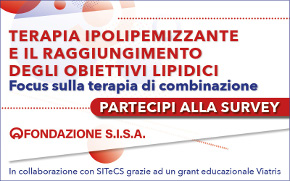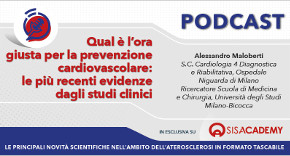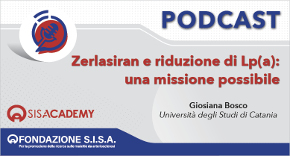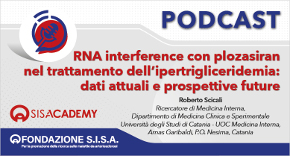 Rivista in lingua italiana
Rivista in lingua italiana
riservata ai Soci SISA
Ultimo numero:
Anno 16 • N.1/2025
SISANews
Dubbi sul valore predittivo della proteina C reattiva nell'infarto miocardico acuto
Sono molti gli studi che hanno dimostrato che alti livelli di proteina C reattiva ad alta sensibilità (hsCRP) sono predittivi di sindrome coronarica acuta. Molti reputano però che l'hsCRP non aggiunga molto ai tradizionali fattori di rischio nel predire la probabilità di malattia cardiovascolare. Questo studio condotto in collaborazione da ricercatori italiani, cinesi e scozzesi agita ulteriormente le acque della polemica mettendo in dubbio il ruolo dell'hsCRP nel predire l'infarto del miocardio. Ben il 41% degli 887 pazienti con infarto del miocardio ricoverati entro 6 ore dall'inizio dei sintomi aveva un livello di hsCRP inferiore ai 2 mg/l (valore considerato "normale") ed il 37% dei controlli aveva un valore ≥ 2 mg/l. In media, i pazienti con infarto mostravano un valore di hsCRP significativamente più alto dei controlli, ma la dispersione dei dati è risultata piuttosto ampia con elevata sovrapposizione tra infarti e controlli. La conclusione è che la misura dell'hsCRP ha un valore limitato nel predire l'infarto del miocardio.
![]()
High-sensitivity C-reactive protein is within normal levels at the very onset of first ST-segment elevation acute myocardial infarction in 41% of cases: a multiethnic case-control study
Cristell N, Cianflone D, Durante A, Ammirati E, Vanuzzo D, Banfi M, Calori G, Latib A, Crea F, Marenzi G, De Metrio M, Moretti L, Li H, Uren NG, Hu D, Maseri A; FAMI Study Investigators.
J Am Coll Cardiol 2011;58:2654-2661
OBJECTIVES: This study sought to assess the prevalence of normal levels of high sensitivity C-reactive protein (hsCRP) at the very onset of ST-segment elevation myocardial infarction (STEMI).
BACKGROUND: Levels of hsCRP =2 mg/l identify individuals who benefit from lipid lowering and possibly anti-inflammatory agents, but how many patients develop infarction in spite of hsCRP levels <2 mg/l and thus would be ineligible for these treatments?
METHODS: We studied 887 patients with unequivocally documented STEMI as the first manifestation of coronary disease and 887 matched control subjects from urban areas of Italy, Scotland, and China. Blood samples were obtained before reperfusion strategies <6 h from symptoms onset in order to limit acute event-related increases.
RESULTS: hsCRP values were similar in samples obtained <2 h, 2 to 4 h, and 4 to 6 h from symptoms onset in all ethnic groups, consistent with the delayed hsCRP elevation after myocardial necrosis and thus indicative of pre-infarction levels. Median hsCRP values were significantly higher in patients than in control subjects: 2.49 (interquartile range [IQR]: 1.18 to 5.55) mg/l versus 1.32 (IQR: 0.58 to 3.10) mg/l (p < 0.0001), which is consistent with previous findings. However, 41% of patients had hsCRP levels <2 mg/l and conversely, 37% of control subjects had values =2 mg/l.
CONCLUSIONS: The measurement of hsCRP, with a 2 mg/l cutoff, would not have predicted 41% of unequivocally documented STEMIs in 3 ethnic groups without evidence of previous coronary disease, thus indicating both its limitations as an individual prognostic marker and as an indicator of a generalized inflammatory pathogenetic component of STEMI. New specific prognostic and therapeutic approaches should be found for such a large fraction of patients at risk.
J Am Coll Cardiol 2011;58:2654-2661

Area Soci
Eventi
39° Congresso Nazionale
 39° Congresso Nazionale
39° Congresso NazionaleRoma, 23-25 novembre 2025
Save the date




 Spring Meeting Gruppi Giovani SID, SIGG, SIIA, SIMI, SIPREC, SISA
Spring Meeting Gruppi Giovani SID, SIGG, SIIA, SIMI, SIPREC, SISARimini, 6-8 aprile 2025
[continua a leggere]
 SISA LIPID ACADEMY - Corso avanzato di lipidologia clinica
SISA LIPID ACADEMY - Corso avanzato di lipidologia clinicaModena, 4-5 Luglio 2024
[continua a leggere]Giornale Italiano Arteriosclerosi
HoFH today
 Rivista Italiana della
Rivista Italiana della
Ipercolesterolemia
Familiare Omozigote
Anno 6 • N.1/2024
Rivista NMCD
Diateca
[continua a leggere]
[continua a leggere]
Newsletter
il vostro indirizzo di posta elettronica
Progetto LIPIGEN
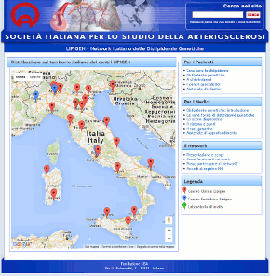
Nuovo sito dedicato al Progetto LIPIGEN
Progetto LIPIGEN - Vecchio portale
E' necessario essere loggati come utente
Lipigen per poter accedere alla pagina
PROject Statin Intolerance SISA
PROSISA – PROject Statin Intolerance SISA
E' necessario essere loggati come utente
PROSISA per poter accedere alla pagina
GILA - Lipoprotein Aferesi
Gruppo Interdisciplinare Lipoprotein Aferesi
(Accesso Gruppo GILA-Lipoprotein Aferesi)
E' necessario essere loggati come utente del Gruppo GILA per poter accedere
Gruppo Interdisciplinare Lipoprotein Aferesi
(Documentazione ad accesso libero)
Pagina informativa per medici e pazienti



